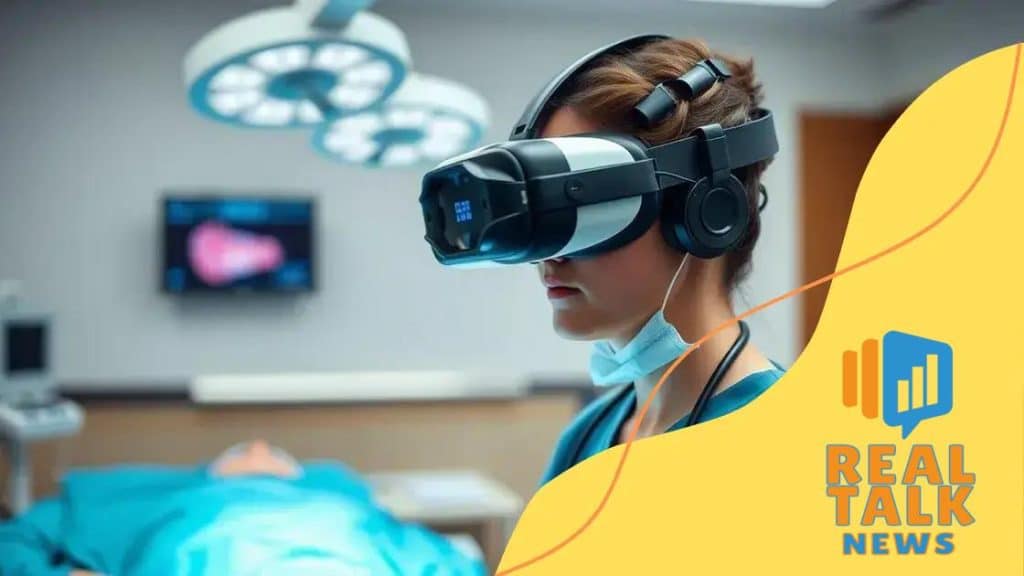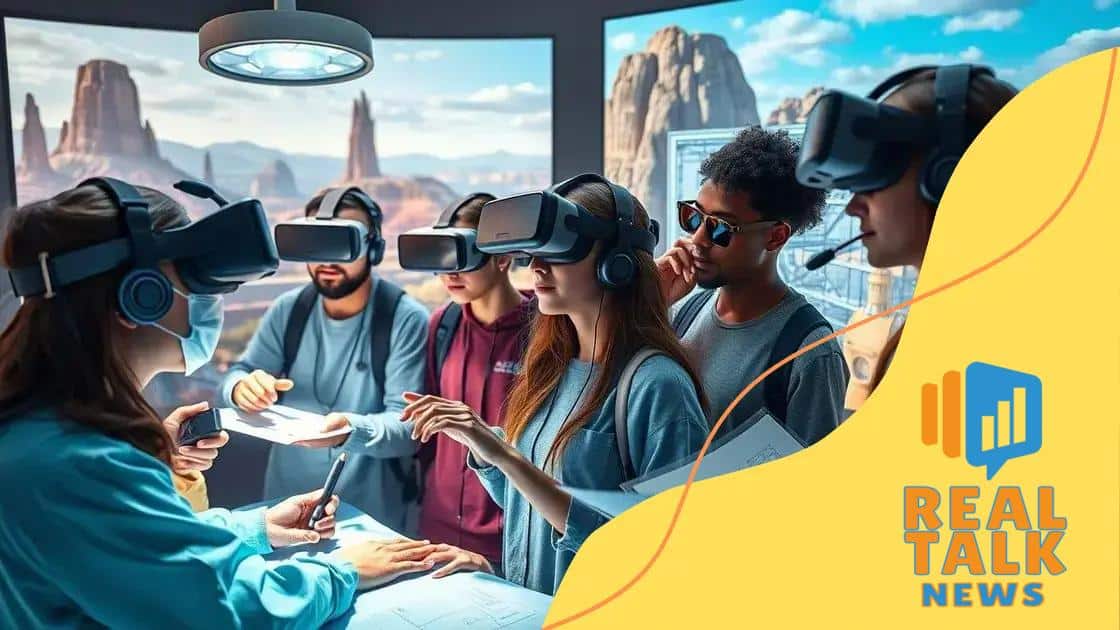The role of virtual reality in medical education

The role of virtual reality in medical education enhances learning through immersive simulations, safe practice environments, and improved collaboration, preparing students effectively for their future healthcare careers.
The role of virtual reality in medical education is quickly changing how aspiring doctors and nurses learn their craft. Imagine a classroom where students can perform surgery in a lifelike environment, making mistakes without real-world consequences. Curious about how this works? Let’s dive in.
Understanding virtual reality in medicine
Understanding virtual reality in medicine is essential for grasping its transformative impact on healthcare education. With advanced technology, students can immerse themselves in realistic simulations, enhancing their learning experience. This innovative approach allows them to practice skills and procedures in a safe environment.
What is virtual reality?
Virtual reality (VR) refers to a computer-generated environment that can simulate real or imagined experiences. In the context of medicine, it enables students to engage in interactive exercises that foster deeper comprehension.
Why is VR important in medical education?
Integrating VR into medical training offers several benefits, such as:
- Safe practice opportunities where students can make mistakes without consequences.
- Enhanced retention of complex concepts through immersive learning.
- Immediate feedback that helps refine skills in real-time.
Moreover, virtual reality can bridge the gap between theory and practice. By replicating real-life scenarios, it prepares students for the challenges they will face in their careers. Environments can be designed for various specialties, from surgery to patient interaction.
Challenges of implementing VR in medicine
Despite its advantages, there are challenges in adopting virtual reality technology in medical schools. These include high costs, the need for specialized training, and integrating VR into existing curriculums. Tackling these obstacles is essential for maximizing the benefits of this innovative tool.
Ultimately, virtual reality enhances the educational experience, helping to cultivate skilled and confident healthcare professionals. As technology advances, its applications in medicine will continue to evolve, paving the way for even more effective training methods.
Benefits of virtual reality for medical training
The benefits of virtual reality for medical training are profound and far-reaching. Utilizing this technology allows students to learn in a way that traditional methods simply cannot match. By engaging in realistic simulations, learners can enhance their skills and build confidence in a risk-free setting.
Immersive learning environments
One key benefit is the creation of immersive learning environments. In these settings, students can practice procedures and interact with virtual patients. This leads to greater retention of knowledge, as experiences are more memorable when they are engaging.
Safe practice opportunities
Virtual reality also provides safe practice opportunities for medical students. They can make mistakes and learn from them without jeopardizing patient safety. This is crucial in fields such as surgery, where precision and technique are vital.
- Hands-on practice in a controlled setting.
- Immediate feedback to improve skills.
- The ability to repeat scenarios for mastery.
This kind of training helps students develop the necessary competencies before entering real clinical environments. Furthermore, VR can simulate a variety of situations, preparing students for diverse patient interactions.
Enhanced teamwork and communication skills
Another advantage is the development of teamwork and communication skills. VR training often involves group scenarios where students must collaborate to solve problems. This dynamic fosters essential interpersonal skills that are key in any healthcare setting.
As virtual reality technology continues to advance, its applications in medical training will expand. The integration of VR not only enriches educational experiences but also enhances the overall quality of healthcare education, resulting in better-prepared professionals.
Real-world applications of VR in education

The real-world applications of VR in education are expanding rapidly, making learning more engaging and effective. This innovative technology is being used in various fields, showing its versatility and potential to transform traditional learning methods.
Medical training
One of the most significant areas is medical training. VR allows students to practice surgical techniques and patient interactions in a safe environment. For example, a student can perform a virtual surgery, improving their skills without any risk to real patients. This immersive experience helps in understanding complex procedures better than traditional methods.
Engineering and design
In engineering and design, VR is also making waves. Students can visualize their projects in a 3D space, enabling them to explore different design options and make adjustments on the fly. This hands-on experience fosters creativity and critical thinking.
- Simulating real-life challenges in engineering projects.
- Testing and modifying designs without physical prototypes.
- Enhancing teamwork by allowing groups to collaborate in virtual spaces.
These applications promote a practical understanding of theoretical concepts, bridging the gap between learning and application.
Language learning
Furthermore, VR is being utilized for language learning. Students can practice speaking with virtual characters and immerse themselves in different cultural settings. This enhances their conversational skills and cultural awareness, making language acquisition more effective.
As educators recognize the value of virtual reality in these real-world applications, we can expect it to become an integral part of curricula across disciplines. Its ability to create engaging, interactive, and safe learning environments truly sets it apart as a powerful educational tool.
Challenges in implementing VR in medical schools
Implementing VR in medical schools presents several challenges that educators and administrators must address. While the technology offers exciting opportunities, integrating it effectively into existing curricula requires careful planning and consideration.
High costs
One major challenge is the high costs associated with virtual reality equipment and software. Purchasing the necessary hardware, such as headsets and computers, can be expensive. Additionally, licensing and maintenance costs can add up over time, making it challenging for schools with limited budgets to adopt this technology.
Need for specialized training
Another obstacle is the need for specialized training for both instructors and students. Educators must learn how to use VR tools effectively and integrate them into their teaching strategies. This training can be time-consuming and may require ongoing support to ensure that all staff are comfortable with the new technology.
- Adapting curricula to include VR experiences.
- Providing technical support for users.
- Ensuring that all students can access and utilize the technology.
Additionally, some faculty members may resist adopting new teaching methods. It can be challenging to convince instructors who are accustomed to traditional methods to embrace such a significant change. Establishing a culture of innovation and openness to new technologies is crucial for successful implementation.
Logistical considerations
Logistical issues can also arise, such as the need for dedicated spaces for VR training. These spaces must be designed to provide a safe and effective learning environment, which may require renovations or adjustments to existing facilities.
Despite these challenges, the potential benefits of virtual reality in medical education are significant. Addressing these obstacles head-on and investing in necessary resources can help medical schools harness the power of VR to enhance training and better prepare future healthcare professionals.
Future trends of virtual reality in healthcare
The future trends of virtual reality in healthcare promise to reshape how medical education and training are conducted. As technology advances, the adoption of VR is expected to grow, leading to more innovative applications and enhancements in healthcare.
Increasing accessibility
One major trend is the increased accessibility of virtual reality tools. As prices for VR equipment decrease, more medical schools and institutions will be able to afford this technology. This democratization of access will allow a broader range of students to benefit from immersive learning experiences.
Integration with artificial intelligence
Another exciting trend is the integration of VR with artificial intelligence (AI). By combining these technologies, healthcare simulations can become more adaptive and responsive. For instance, AI can create realistic scenarios based on a user’s past performance, allowing for personalized training experiences.
- Adaptive learning environments that change based on user interaction.
- Enhanced analytics to track progress over time.
- Real-time feedback that aids in skill development.
This combination can lead to more dynamic training sessions, helping future healthcare professionals learn more efficiently.
Expanded applications
Additionally, we can expect expanded applications of VR in various healthcare fields beyond education. For example, VR is already being used in pain management and rehabilitation. Patients can engage in virtual environments to distract them from pain or help them recover from injuries.
As research continues, new applications will likely emerge, integrating VR further into patient care and treatment methodologies. This could revolutionize how healthcare providers interact with patients and manage treatment plans.
The trends in virtual reality for healthcare indicate a bright future. As technology becomes more pervasive and advanced, its impact on medical training and patient care will continue to grow, providing exciting opportunities for both students and professionals.
FAQ – Frequently Asked Questions about Virtual Reality in Medical Education
What are the main benefits of using virtual reality in medical education?
The main benefits include enhanced learning through realistic simulations, safe practice opportunities, and improved collaboration among students.
What challenges do medical schools face when implementing VR technology?
Challenges include high costs, the need for specialized training for faculty, and integrating VR into existing curricula.
How can virtual reality improve patient care beyond medical training?
VR can be used in pain management and rehabilitation, helping patients engage in therapeutic environments to aid recovery.
What future trends can we expect for virtual reality in healthcare?
Future trends include increased accessibility, integration with artificial intelligence, and expanded applications in various healthcare fields.





